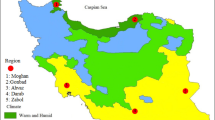Abstract
Evaluation of yield performance and its stability is essential for yield trials conducted in different environments. We determined the forage yield stability of 24 tall fescue (Festuca arundinacea Schreb.) genotypes using different parametric and non-parametric stability measures and compared those stability statistics across 14 test environments (combination of year, location and moisture conditions) during 2008-2013 growing seasons. The results of parametric measures totally indicated that genotypes G21 and G3 were the most stable ones. However, the non-parametric measures identified G15 followed by G11, G3 and G13 as the most stable genotypes. These genotypes may be recommended for genetic improvement of tall fescue with high degree of adaptation. Principal component analysis based on the rank correlation matrix indicated that most of the non-parametric measures were significantly inter-correlated with parametric measures and therefore seem to be useful alternatives to complement parametric measures. Based on the static and dynamic concepts, the results revealed that stability measures can be classified into three groups.

Similar content being viewed by others
References
Allen RG, Pereira LS, Raes D, Smith M (1998) Crop evapotranspiration-Guidelines for computing crop water requirements-FAO Irrigation and drainage paper 56. Rome, Italy
Annicchiarico P (2002) 24 Defining adaptation strategies and yield-stability targets in breeding programmes. In: Kang MS (ed) Quantitative genetics, genomics, and plant breeding. CABI, Wallingford, pp 365–383
Becker HC, Leon J (1988) Stability analysis in plant breeding. Plant Breed 101:1–23
Casler MD, Fales SL, McElroy AR, Hall MH, Hoffman LD, Leath KT (2000) Genetic progress from 40 years of orchard-grass breeding in North America measured under hay management. Crop Sci 40:1019–1024
Clarke Topp C, Parkin GW, Ferre TPA (2008) Soil water content. In: Carter MR, Gregorich EG (eds) Soil sampling and methods of analysis. CRC Press, Boca Raton, FL: Canadian Society of Soil Science, pp 939–961
Eberhart SAT, Russell WA (1966) Stability parameters for comparing varieties. Crop Sci 6:36–40
Ebrahimiyan M, Majidi MM, Mirlohi A, Gheysari M (2012) Drought-tolerance indices in a tall fescue population and its polycross progenies. Crop Pasture Sci 63:360–369
Eskridge KM (1990) Selection of stable cultivars using a safety-first rule. Crop Sci 30:369–374
Flores F, Moreno MT, Cubero JI (1998) A comparison of univariate and multivariate methods to analyze G × E interaction. Field Crop Res 56:271–286
Francis TR, Kannenberg LW (1978) Yield stability studied in short-season maize. I. A descriptive method for grouping genotypes. Can J Plant Sci 58:1029–1034
Gauch HG Jr. (2007) MATMODEL version 3.0: Open source software for AMMI and related analyses. Available at http://www.css.cornell.edu/staff/gauch (verified 27 Feb. 2008). Crop and Soil Sciences, Cornell Univ., Ithaca, NY
Gauch HG, Zobel RW (1996) AMMI analysis of yield trials. In: Kang MS, Gauch HG (eds) Genotype by environment interaction. CRC Press, Boca Raton, pp 85–122
Huang B, Gao H (2000) Root physiological characteristics associated with drought resistance in tall fescue cultivars. Crop Sci 40:196–203
Huehn M (1990) Nonparametric measures of phenotypic stability. Part 1: Theory. Euphytica 47:189–194
Huehn M (1996) Nonparametric analysis of genotype x environment interactions by ranks. Genotype by Environ Interact CRC Press, Boca Raton, FL, pp 213–228
Hühn M (1979) Beitrage zur erfassung der phanotypischen stabilitat. EDV Med Biol 10:112–117
Hühn M, Léon J (1995) Nonparametric analysis of cultivar performance trials: experimental results and comparison of different procedures based on ranks. Agron J 87:627–632
Kang MS (1988) A rank-sum method for selecting high-yielding, stable corn genotypes. Cereal Res Commun 16:113–115
Kang MS, Pham HN (1991) Simultaneous selection for high yielding and stable crop genotypes. Agron J 83:161–165
Lin CS, Binns MR (1988) A method of analyzing cultivar × location × year experiments: a new stability parameter. Theor Appl Genet 76:425–430
Lin C-S, Binns MR, Lefkovitch LP (1986) Stability analysis: where do we stand? Crop Sci 26:894–900
Majidi MM, Mirlohi A, Amini F (2009) Genetic variation, heritability and correlations of agro-morphological traits in tall fescue (Festuca arundinacea Schreb.). Euphytica 167:323–331
Mohammadi R, Abdulahi A, Haghparast R, Armion M (2007) Interpreting genotype × environment interactions for durum wheat grain yields using nonparametric methods. Euphytica 157:239–251
Nassar R, Huehn M (1987) Studies on estimation of phenotypic stability: Tests of significance for nonparametric measures of phenotypic stability. Biometrics 43:45–53
Norton MR, Volaire F, Lelievre F (2006) Summer dormancy in Festuca arundinacea Schreb.; the influence of season of sowing and a simulated mid-summer storm on two contrasting cultivars. Crop Pasture Sci 57:1267–1277
Purchase JL, Hatting H, Van Deventer CS (2000) Genotype × environment interaction of winter wheat (Triticum aestivum L.) in South Africa: II. Stability analysis of yield performance. South African J Plant Soil 17:101–107
Sabaghnia N, Dehghani H, Sabaghpour SH (2006) Nonparametric methods for interpreting genotype × environment interaction of lentil genotypes. Crop Sci 46:1100–1106
Shah SH, Shah SM, Khan MI et al (2009) Nonparametric methods in combined heteroscedastic experiments for assessing stability of wheat genotypes in Pakistan. Pak J Bot 41:711–730
Sneller CH, Kilgore-Norquest L, Dombek D (1997) Repeatability of yield stability statistics in soybean. Crop Sci 37:383–390
Tai GCC (1971) Genotypic stability analysis and its application to potato regional trials. Crop Sci 11:184–190
Tiiennarasu K (1995) On certain non-parametric procedures for studying genotype-environment interactions and yield stability. Ph.D. thesis. PJ School, IARI, New Delhi, India
Van Eeuwijk FA, Cooper M, DeLacy IH et al (2001) Some vocabulary and grammar for the analysis of multi-environment trials, as applied to the analysis of FPB and PPB trials. Euphytica 122:477–490
Wricke G (1962) Uber eine Methode zur Erfassung der okologischen Streubreite in Feldversuchen. Zeitschrift Fur Pflanzenzuchtung-J. Plant Breed 47:92–96
Yue GL, Roozeboom KL, Schapaugh WT, Liang GH (1997) Evaluation of soybean cultivars using parametric and nonparametric stability estimates. Plant Breed 116:271–275
Author information
Authors and Affiliations
Corresponding author
Rights and permissions
About this article
Cite this article
Dehghani, M.R., Majidi, M.M., Mirlohi, A. et al. Integrating parametric and non-parametric measures to investigate genotype × environment interactions in tall fescue. Euphytica 208, 583–596 (2016). https://doi.org/10.1007/s10681-015-1611-0
Received:
Accepted:
Published:
Issue Date:
DOI: https://doi.org/10.1007/s10681-015-1611-0




